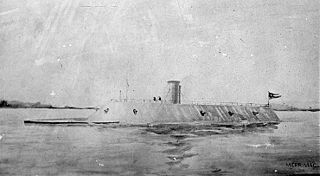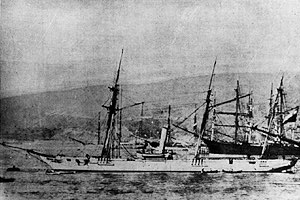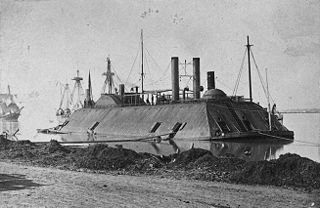This article needs additional citations for verification .(September 2016) |





A floating battery is a kind of armed watercraft, often improvised or experimental, which carries heavy armament but has few other qualities as a warship.
This article needs additional citations for verification .(September 2016) |





A floating battery is a kind of armed watercraft, often improvised or experimental, which carries heavy armament but has few other qualities as a warship.
Use of timber rafts loaded with cannon by Danish defenders of Copenhagen against bomb ketches of a combined British-Dutch-Swedish fleet is attested by Nathaniel Uring in 1700. [1]
In 1727, Spanish engineer Juan de Ochoa proposed King Philip V his project of the barcaza-espín ("barge-porcupine"), heavily armored floating batteries moved by rows and fitted with multiple rams. The end of the Anglo-Spanish War, however, buried the project without it being ever implemented. [2]
An early appearance was in 1782 at the Great Siege of Gibraltar, and its invention and usage is attributed to French engineer Jean Le Michaud d'Arçon.
A purpose-built floating battery was Flådebatteri No. 1, [3] designed by Chief Engineer Henrik Gerner in 1787; it was 47 m (154 ft) long, 13 m (43 ft) wide and armed with 24 guns, and was used during the 1801 Battle of Copenhagen under the command of Peter Willemoes. The British made limited use of floating batteries during the French Revolutionary and Napoleonic Wars, with the two-vessel Musquito and Firm-class floating batteries, and some individual vessels such as HMS Redoubt.
The most notable floating batteries were built or designed in the 19th century, and are related to the development of the first steam warship and the ironclad warship.
Demologos , the first steam-propelled warship, was a floating battery designed for the protection of New York Harbor in the War of 1812.
In the 1850s, the British and French navies deployed iron-armoured floating batteries as a supplement to the wooden steam battlefleet in the Crimean War. The role of the battery was to assist unarmoured mortar and gunboats bombarding shore fortifications. The French used their batteries in 1855 against the defenses at Kinburn on the Black Sea, where they were effective against Russian shore defences. The British planned to use theirs in the Baltic Sea against Kronstadt, and may have been influential in causing the Russians to sue for peace. [4] However, Kronstadt was widely regarded as the most heavily fortified naval arsenal in the world throughout most of the 19th-century, continually upgrading its combined defences to meet new changes in technology. Even as the British armoured-batteries were readied against Kronstadt in early 1856, the Russians had already constructed newer networks of outlying forts, mortar batteries of their own, and submarine mines against which the British had no system for removing under fire.
Traditional floating battery called kotta mara was used by the Banjar and Dayak against the Dutch during the Banjar war (1859–1906). The battery is made by adding walls (sloped and unsloped) to a raft made by large logs. Some of them shaped like a castle and had bastions with 4 cannons on each bastion. The kotta mara could resist the Dutch 30-pounder cannons until 24.5 m range, the range which the cannon could effectively penetrate it. [5]
Floating batteries were popularly implemented by both the Union and the Confederacy during the American Civil War. The first was the Confederate Floating Battery of Charleston Harbor, which took an active part in the bombardment of Fort Sumter in April 1861. Experimental ironclad vessels that proved too cumbersome or were underpowered were often converted into floating batteries and posted for river and coastal waterway control. Here too, Civil War batteries and even ironclads such as the famed monitors, were acutely vulnerable to mines protected in turn by forts. As a result, the combined defences of Charleston, South Carolina, for example, were never overwhelmed by the Union Navy.

CSS Virginia was the first steam-powered ironclad warship built by the Confederate States Navy during the first year of the American Civil War; she was constructed as a casemate ironclad using the razéed original lower hull and engines of the scuttled steam frigate USS Merrimack. Virginia was one of the participants in the Battle of Hampton Roads, opposing the Union's USS Monitor in March 1862. The battle is chiefly significant in naval history as the first battle between ironclads.

An ironclad was a steam-propelled warship protected by steel or iron armor constructed from 1859 to the early 1890s. The ironclad was developed as a result of the vulnerability of wooden warships to explosive or incendiary shells. The first ironclad battleship, Gloire, was launched by the French Navy in November 1859, narrowly preempting the British Royal Navy. However, Britain built the first completely iron-hulled warships.

A warship or combatant ship is a ship that is built and primarily intended for naval warfare. Usually they belong to the armed forces of a nation. As well as being armed, warships are designed to withstand damage and are typically faster and more maneuverable than merchant ships. Unlike a merchant ship, which carries cargo, a warship typically carries only weapons, ammunition and supplies for its crew. Warships usually belong to a navy, though they have also been operated by individuals, cooperatives and corporations.

The Confederate States Navy (CSN) was the naval branch of the Confederate States Armed Forces, established by an act of the Confederate States Congress on February 21, 1861. It was responsible for Confederate naval operations during the American Civil War against the United States's Union Navy.

Turret ships were a 19th-century type of warship, the earliest to have their guns mounted in a revolving gun turret, instead of a broadside arrangement.

The schooner Virgen de Covadonga, was a schooner built in Spain and launched in 1859. During the Spanish-South American War (1863-1866), it was captured by Chilean forces at the end of the Papudo naval action and incorporated into the Chilean Navy. After being assigned to exploration missions, she was later assigned to the Chilean squadron that participated in the Pacific War (1879-1883). In the Battle of Punta Gruesa defeated the Ironclad Independencia.

The Battle of Kinburn, a combined land-naval engagement during the final stage of the Crimean War, took place on the tip of the Kinburn Peninsula on 17 October 1855. During the battle a combined fleet of vessels from the French Navy and the British Royal Navy bombarded Russian coastal fortifications after an Anglo-French ground force had besieged them. Three French ironclad batteries carried out the main attack, which saw the main Russian fortress destroyed in an action that lasted about three hours.

Demologos was the first warship to be propelled by a steam engine. She was a wooden floating battery built to defend New York Harbor from the Royal Navy during the War of 1812. The vessel was designed to a unique pattern by Robert Fulton, and was renamed Fulton after his death. Because of the prompt end of the war, Demologos never saw action, and no other ship like her was built.

Lave was an ironclad floating battery of the French Navy during the 19th century. She was part of the Dévastation class of floating batteries.

Marceau was an ironclad barbette ship built for the French Navy during the 1880s, the lead ship of her class. She served in the Mediterranean Squadron until 1900, when she was rebuilt and subsequently placed in reserve. She returned to service in 1906 as a torpedo training ship. During World War I, she served in Malta and Corfu as a submarine tender. The old ironclad was sold for scrapping in 1920, and while being towed to Toulon, she ran aground in a gale off Bizerte and became stranded. The wreck remained visible there until the 1930s.

The Aetna-class ironclad floating batteries were built during the Crimean War for the attack of Russian coastal fortifications.

The Battle of Lucas Bend took place on January 11, 1862, near Lucas Bend, four miles north of Columbus on Mississippi River in Kentucky as it lay at the time of the American Civil War. In the network of the Mississippi, Tennessee and Ohio rivers, the Union river gunboats under Flag Officer Andrew Hull Foote and General Ulysses S. Grant sought to infiltrate and attack the Confederate positions in Tennessee. On the day of the battle, the Union ironclads Essex and St Louis, transporting troops down the Mississippi in fog, engaged the Confederate cotton clad warships General Polk, Ivy and Jackson and the gun platform New Orleans at a curve known as Lucas Bend in Kentucky. The Essex, under Commander William D. Porter, and the St Louis forced the Confederate ships to fall back after an hour of skirmishing during which the Union commander was wounded. They retreated to the safety of a nearby Confederate battery at Columbus, where the Union vessels could not follow.

The Palestro-class ironclad floating batteries were four floating batteries built for the French Navy in 1859–1862 to replace the Crimean War-built vessels because of fears that the 1855 ships would deteriorate because they had been built hurriedly with poor wood.

The Erzherzog Ferdinand Max class consisted of a pair of ironclad warships—Erzherzog Ferdinand Max and Habsburg—built for the Austrian Navy in the 1860s. They were the last broadside armored frigates to be built for the Austrian Empire, and the last vessels completed to see action against the Italians at the Battle of Lissa in 1866. Intended to have been armed with new breech-loading Krupp guns, the outbreak of the Seven Weeks' War prevented the delivery of the guns, forcing the Austrian Navy to arm the ships with a battery of sixteen older 48-pounder muzzle-loading guns.

Kottamara is a type of floating battery or fortified raft from Borneo. It is used by native Bornean in warfare, its usage rose prominently during the Banjarmasin war (1859–1906). Kotta mara is used in riverine warfare, as an armed vessel or simply a blockhouse or fortification to prevent enemy advance in the river.

Requin was an ironclad barbette ship built for the French Navy in the late 1870s and early 1880s. She was last member of the four-ship Terrible class. They were built as part of a fleet plan started in 1872, which by the late 1870s had been directed against a strengthening Italian fleet. The ships were intended for coastal operations, and as such had a shallow draft and a low freeboard, which greatly hampered their seakeeping and thus reduced their ability to be usefully employed outside of coastal operations after entering service. Armament consisted of a pair of 420 mm (16.5 in) guns in individual barbettes, the largest-caliber gun ever mounted on a French capital ship. Requin was laid down in 1878 and was completed in 1887.

Turenne was an ironclad barbette ship of the French Navy built in the 1870s and 1890s; she was the second and final member of the Bayard class. Intended for service in the French colonial empire, she was designed as a "station ironclad", which were smaller versions of the first-rate vessels built for the main fleet. The Bayard class was a scaled down variant of Amiral Duperré. They carried their main battery of four 240 mm (9.4 in) guns in open barbettes, two forward side-by-side and the other two aft on the centerline. Turenne was laid down in 1877 and was commissioned in 1882.

The Bayard class was a pair of two ironclad warships built for the French Navy in the late 1870s and early 1880s. The class comprised two ships: Bayard and Turenne. The class is sometimes referred to as the Turenne class. They were based on the ironclad Amiral Duperré, adopting the same general arrangement, but were scaled down in size. They were intended for use overseas in the French colonial empire, and as such, they retained a sailing rig for long-range cruising and copper sheathing for their hulls to protect them when they would be unable to be dry-docked regularly. They carried a main battery of four 240 mm (9.4 in) guns that were mounted in individual barbettes; two were in sponsons forward, abreast of the conning tower, and the other two were on the centerline aft.